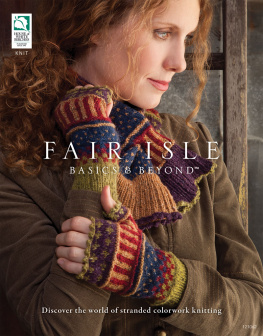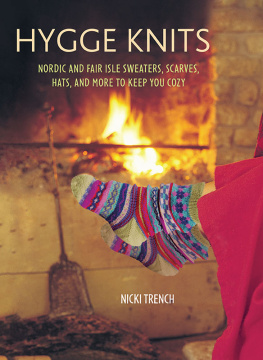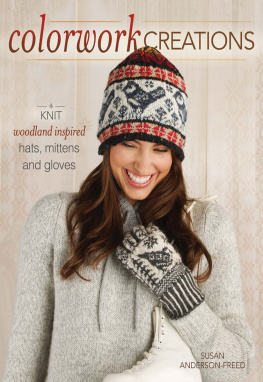Sheila McGregor - Traditional Fair Isle Knitting
Here you can read online Sheila McGregor - Traditional Fair Isle Knitting full text of the book (entire story) in english for free. Download pdf and epub, get meaning, cover and reviews about this ebook. genre: Home and family. Description of the work, (preface) as well as reviews are available. Best literature library LitArk.com created for fans of good reading and offers a wide selection of genres:
Romance novel
Science fiction
Adventure
Detective
Science
History
Home and family
Prose
Art
Politics
Computer
Non-fiction
Religion
Business
Children
Humor
Choose a favorite category and find really read worthwhile books. Enjoy immersion in the world of imagination, feel the emotions of the characters or learn something new for yourself, make an fascinating discovery.

- Book:Traditional Fair Isle Knitting
- Author:
- Genre:
- Rating:4 / 5
- Favourites:Add to favourites
- Your mark:
- 80
- 1
- 2
- 3
- 4
- 5
Traditional Fair Isle Knitting: summary, description and annotation
We offer to read an annotation, description, summary or preface (depends on what the author of the book "Traditional Fair Isle Knitting" wrote himself). If you haven't found the necessary information about the book — write in the comments, we will try to find it.
Traditional Fair Isle Knitting — read online for free the complete book (whole text) full work
Below is the text of the book, divided by pages. System saving the place of the last page read, allows you to conveniently read the book "Traditional Fair Isle Knitting" online for free, without having to search again every time where you left off. Put a bookmark, and you can go to the page where you finished reading at any time.
Font size:
Interval:
Bookmark:

A Shetland couple from Gulberwick, in traditional dress (Dennis Coutts)


Planet Friendly Publishing
Made in the United States
Printed on Recycled Paper
Text: 10% Cover: 10%
Learn more: www.greenedition.org
At Dover Publications were committed to producing books in an earth-friendly manner and to helping our customers make greener choices.
Manufacturing books in the United States ensures compliance with strict environmental laws and eliminates the need for international freight shipping, a major contributor to global air pollution.
And printing on recycled paper helps minimize our consumption of trees, water and fossil fuels. The text of Traditional Fair Isle Knitting was printed on paper made with 10% post-consumer waste, and the cover was printed on paper made with 10% post-consumer waste. According to Environmental Defenses Paper Calculator, by using this innovative paper instead of conventional papers, we achieved the following environmental benefits:
Trees Saved: 6 Air Emissions Eliminated: 437 pounds
Water Saved: 2,102 gallons. Solid Waste Eliminated: 128 pounds
For more information on our environmental practices, please visit us online at www.doverpublications.com/green
Copyright
Copyright 1981 by Sheila McGregor
All rights reserved.
Bibliographical Note
This Dover edition, first published in 2003, is a slightly corrected reprint of the first U.S. edition of The Complete Book of Traditional Fair Isle Knitting , published by Charles Scribners Sons, New York, in 1982. The book was originally published by B. T. Batsford and Company, London, in 1981. For this edition, the list of Stockists has been omitted and the color section has been expanded and rearranged.
Library of Congress Cataloging-in-Publication Data
McGregor, Sheila.
Traditional Fair Isle knitting / Sheila McGregor.
p. cm.
Rev. reprint of: The complete book of traditional Fair Isle knitting. New York : Charles Scribners Sons, 1982.
9780486134215
ISBN-10: 0-486-43107-X (pbk.)
1. KnittingScotlandFair IslePatterns. I. McGregor, Sheila. Complete book of traditional Fair Isle knitting. II. Title.
TT819.G72.S363 2003
746.4320410941135dc21
2003048897
Manufactured in the United States by Courier Corporation
43107X06
www.doverpublications.com
This book has been in preparation for several years and I owe a considerable debt to a great many people, principally to the friendly and skilful knitters of Shetland. Special mention must be made of the Shetland Federation of the Scottish Womens Rural Institutes and its individual members in many parts. I am also most grateful to the staffs of the Shetland Museum, Lerwick, the National Museum of Antiquities of Scotland in Edinburgh (NMAS), the Royal Scottish Museum, also in Edinburgh, the Victoria and Albert Museum in London and the National Library of Scotland, Edinburgh. I have greatly appreciated their consistent and courteous interest and practical help.
Much help has been received from other individuals, in particular from the late Dr George Waterston, Mr K. G. Ponting, Dr Michael Ryder, Mr Walter Scott, Mr John Johnston, Mr Gilbert Johnston and Mr Michael Peterson. Invaluable assistance has been given by Mr Pieter Hintjens, without whose labours in the darkroom this book would not have been possible, and other photographers and friends. Those illustrations not credited are from the authors collection.
Although in some cases the knitters of garments used in illustrations are known to me, it has been impossible to trace all of them. It was therefore decided that individual acknowledgement of knitters would be inappropriate. To all of these highly skilled and original craftswomen goes this common acknowledgement of their essential contribution to this record of their achievement.
Hand knitting, once a major British industry, has regained much of its former respectability since the days, not long ago, when it was described as a suitable occupation only for the aged and feeble-minded.
In one part of Britain, the Shetland Islands, a group of islands off the north-east tip of Scotland beyond the Orkneys, hand knitting has persisted as a cottage industry over almost 500 years. Various factors now threaten this old heritage, particularly North Sea oil and the prosperity brought by the influx of oil-related jobs. In many communities (though not in all) the most expert knitters are increasingly the elderly ones, and there is some danger that old skills and old patterns may be lost. Now seems therefore an appropriate point to make a comprehensive record of the craft of stranded knitting in Shetland.
To most people this is more familiar as Fair Isle knitting, and indeed it was in Fair Isle, an outlying island of the Shetland group, that this brightly coloured and patterned stranded knitting was first developed. It uses two colours in each row and the wool not in use is stranded along the back in short loops. This forms a double fabric which is extremely warm and resistant to all but the worst weather.
It is possible, but not very relevant, to distinguish between the Fair Isle knitting of Fair Isle and the Fair Isle knitting of the rest of Shetland. The purely Fair Isle period lasted from about 1850 to 1910 or so; thereafter most other parts of Shetland began to produce very similar stranded knitting, using the old patterns of Fair Isle, possibly some small local ones from other islands, and adding a great many from other sources. Today most knitting in Shetland is of Fair Isle typestranded knitting using the traditional patterns which have been collected here. Fair Isle itself, sadly, is no longer a very active centre, but the fishing islands of Whalsay, Burra and the Out Skerries, together with Lerwick on the largest island, Mainland, have thriving and innovative communities of knitters.
Both techniques and patterns have been recorded here. The unusual knitting method used in Shetland is mentioned but not stressed. It is quite possible to knit these patterns with any technique, so long as the circular method is followed. (This is described in Chapter 4: Knitting Techniques.)
The Pattern Notebook in Part Three contains the many patterns familiar to Shetland knitters, arranged according to size. My apologies are extended for any favourites inadvertently omitted. These patterns are all regarded by the Shetlanders as traditional.
The main source has been present-day knitters and knitwear but old patterns from museum pieces have been recorded as well. Besides their great interest to hand knitters, these patterns will be found useful by other craft workers and are adaptable to many types of embroidery as well as to machine knitting.
The origins of this amazing collection of patterns have aroused much speculation and some controversy. The writer has spent considerable time over the past few years investigating the popular theories and believes that while her account is not complete it is based on fact rather than romantic fiction. The remarkable achievements of the hand knitters of nineteenth-century Fair Isle, who produced brilliant and exciting knitting in surroundings of extreme povery and hardship, deserve more credit than is generally given.
Font size:
Interval:
Bookmark:
Similar books «Traditional Fair Isle Knitting»
Look at similar books to Traditional Fair Isle Knitting. We have selected literature similar in name and meaning in the hope of providing readers with more options to find new, interesting, not yet read works.
Discussion, reviews of the book Traditional Fair Isle Knitting and just readers' own opinions. Leave your comments, write what you think about the work, its meaning or the main characters. Specify what exactly you liked and what you didn't like, and why you think so.





